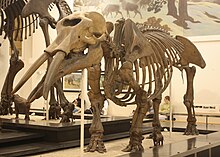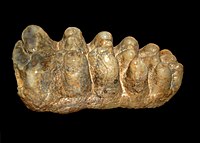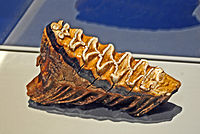Gomphotheres are an extinct group of proboscideans related to modern elephants. They were widespread across Africa Eurasia and North America during the Miocene and Pliocene epochs and dispersed into South America during the Pleistocene as part of the Great American Interchange. Gomphotheres are a paraphyletic group that is ancestral to Elephantidae, which contains modern elephants, as well as Stegodontidae. While most famous forms such as Gomphotherium had long lower jaws with tusks, which is the ancestral condition for the group, some later members developed shortened (brevirostrine) lower jaws with either vestigial or no lower tusks, looking very similar to modern elephants, an example of parallel evolution, which outlasted the long-jawed gomphotheres. By the end of the Early Pleistocene, gomphotheres became extinct in Afro-Eurasia, with the last two genera, Cuvieronius ranging from southern North America to western South America, and Notiomastodon having a wide range over most of South America until the end of the Pleistocene around 12,000 years ago, when they became extinct following the arrival of humans.
| Gomphothere Temporal range: Late Oligocene - Holocene | |
|---|---|
 | |
| Specimen of Gomphotherium productum at the American Museum of Natural History | |
 | |
| Notiomastodon platensis Centro Cultural del Bicentenario de Santiago del Estero in Argentina | |
| Scientific classification | |
| Domain: | Eukaryota |
| Kingdom: | Animalia |
| Phylum: | Chordata |
| Class: | Mammalia |
| Order: | Proboscidea |
| Superfamily: | †Gomphotherioidea |
| Family: | †Gomphotheriidae (Hay, 1922) A. Cabrera 1929 |
| Genera | |
| |
The name "gomphothere" comes from Ancient Greek γόμφος (gómphos), "peg, pin; wedge; joint" plus θηρίον (theríon), "beast".
Description


Gomphotheres differed from elephants in their tooth structure, particularly the chewing surfaces on the molar teeth. The teeth are considered to be bunodont, that is, having rounded cusps.[1] They are thought to have chewed differently from modern elephants, using an oblique movement (combining back to front and side to side motion) over the teeth rather than the proal movement (a forwards stroke from the back to the front of the lower jaws) used by modern elephants and stegodontids.[2] Like modern elephants and other members of Elephantimorpha, gomphotheres had horizontal tooth replacement, where teeth would progressively migrate towards the front of the jaws before they were taken the place of by more posterior teeth. Unlike modern elephants, many gomphotheres retained permanent premolar teeth[3] though they were absent in some gomphothere genera.[4] Earlier gomphotheres had lower jaws with an elongate mandibular symphysis and lower tusks, the primitive condition for members of Elephantimorpha. Later members developed shortened (brevirostrine) lower jaws and/or vestigial or no lower tusks, a convergent process that occurred multiple times among gomphotheres, as well as other members of Elephantimorpha.[4] The incisors and long lower jaws of primitive gomphotheres were likely used for cutting vegetation, while brevirostrine gomphotheres relied on their trunks to acquire food similar to modern elephants.[5]
- Largely unworn molar of Gomphotherium angustidens, a "trilophodont gomphothere"
- Worn molar of Gomphotherium angustidens
- Molar of Tetralophodon, a "tetralophodont gomphothere "
- Molar of a modern African elephant (Loxodonta) for comparison
Taxonomy
"Gomphotheres" are assigned to their own family, Gomphotheriidae, but are widely agreed to be a paraphyletic group. The families Choerolophodontidae and Amebelodontidae (the latter of which includes "shovel tuskers" with flattened lower tusks like Platybelodon) are sometimes considered gomphotheres sensu lato,[6][7][8] though some authors argue that Amebelodontidae should be sunk into Gomphotheriidae.[9] Gomphotheres are divided into two informal groups, "trilophodont gomphotheres", and "tetralophodont gomphotheres". "Tetralophodont gomphotheres" are distinguished from "trilophodont gomphotheres" by the presence of four ridges on the fourth premolar and on the first and second molars, rather than the three present in trilophodont gomphotheres.[6] Some authors choose to exclude "tetralophodont gomphotheres" from Gomphotheriidae, and instead assign them to the group Elephantoidea.[6] "Tetralophodont gomphotheres" are thought to have evolved from "trilophodont gomphotheres", and are suggested to be ancestral to Elephantidae, the group which contains modern elephants, as well as Stegodontidae.[10]
While the North American long jawed proboscideans Gnathabelodon, Eubelodon and Megabelodon been assigned to Gomphotheriidae in some studies[4][11] other studies suggest that they should be assigned to Amebelodontidae (Eubelodon, Megabelodon) or Choerolophodontidae (Gnathabelodon).[5]
Cladogram of Elephantimorpha after Li et al. 2023, showing a paraphyletic Gomphotheriidae.[5]
| Elephantimorpha |
| |||||||||||||||||||||||||||||||||||||||||||||
Ecology
Gomphotheres are generally supposed to have been flexible feeders, with the various species having differing browsing, mixed feeding and grazing diets, with the dietary preference of individual species and populations being shaped by local factors such as climactic conditions and competition.[12] Analysis of the tusks of a male Notiomastodon individual suggest that it underwent musth, similar to modern elephants.[13] Notiomastiodon is also suggested to have lived in social family groups, like modern elephants.[14]
Evolutionary history
Gomphotheres originated in Afro-Arabia during the mid-Oligocene, with remains from the Shumaysi Formation in Saudi Arabia dating to around 29-28 million years ago. Gomphotheres were uncommon in Afro-Arabia during the Oligocene.[15] Gomphotheres arrived in Eurasia after the connection of Afro-Arabia and Eurasia during the Early Miocene around 19 million years ago,[16] in what is termed the "Proboscidean Datum Event". Gomphotherium arrived in North America around 16 million years ago,[17] and is suggested to be the ancestor of later New World gomphothere genera.[18] "Trilophodont gomphotheres" dramatically declined during the Late Miocene, likely due to the increasing C4 grass-dominated habitats,[16] while during the Late Miocene "tetralophodont gomphotheres" were abundant and widespread in Eurasia, where they represented the dominant group of proboscideans.[19] All trilophodont gomphotheres, with the exception of the Asian Sinomastodon, became extinct in Eurasia by the beginning of the Pliocene,[20] along with the global extinction of the "shovel tusker" amebelodontids.[21] The last gomphotheres in Africa, represented by the "tetralophodont gomphothere" genus Anancus, became extinct around the end of the Pliocene and beginning of the Pleistocene.[22] The New World gomphothere genera Notiomastodon and Cuvieronius dispersed into South America during the Pleistocene, around or after 2.5 million years ago as part of the Great American Biotic Interchange due to the formation of the Isthmus of Panama, becoming widespread across the continent.[23] The last gomphothere native to Europe, Anancus arvernensis[24] became extinct during the Early Pleistocene, around 1.6–2 million years ago[25][26] Sinomastodon became extinct at the end of the Early Pleistocene, around 800,000 years ago.[27] From the latter half of the Early Pleistocene onwards, gomphotheres were extirpated from most of North America, likely due to competition with mammoths and mastodons.[12]
The extinction of gomphotheres in Afro-Eurasia has generally been supposed to be the result the expansion of Elephantidae and Stegodon.[20][28] The morphology of elephantid molars being more efficient than gomphotheres in consuming grass, which became more abundant during the Pliocene and Pleistocene epochs.[28] In southern North America, Central America and South America, gomphotheres did not become extinct until shortly after the arrival of humans to the Americas, approximately 12,000 years ago, as part of the Late Pleistocene megafauna extinctions of most large mammals across the Americas. Bones of the last gomphothere genera, Cuvieronius and Notiomastodon, dating to shortly before their extinction have been found associated with human artifacts, suggesting that hunting may have played a role in their extinction.[23]
References
External links
- "Buried Treasure in the Sierra Nevada Foothills". Sierra College. Archived from the original on 2019-07-27. Retrieved 2014-05-21. (article about a fossil exhibit at the Sierra College Natural History Museum)
- "Gomphothere description including images". Sierra College. Archived from the original on 2019-07-27. Retrieved 2014-05-21.
- ""King Tusk" Gomphothere Excavation". Sierra College. Archived from the original on 2019-07-27. Retrieved 2014-05-21. (photos from the excavation of a Gomphothere skeleton on the Sierra College website)
- "The Gomphotheriidae". University of California Museum of Paleontology.



